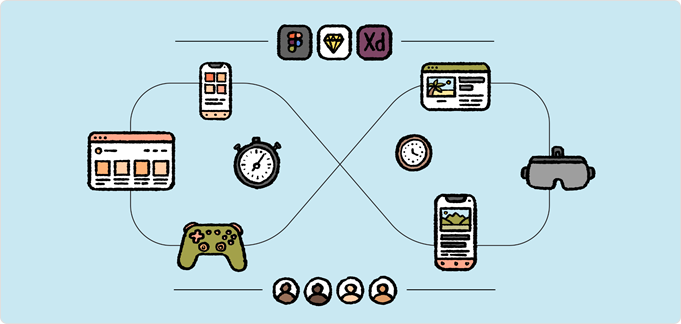In the modern age of technology, any business can be global, so UX is now vital! One of the most essential challenges companies face is to make sure that digital products capture the hearts and minds of users in different cultures and languages.
If your interface does not resonate with users, or even worse, culturally fails in such an obvious way that it confuses a user and drives them away, you risk destroying market share and brand equity. That is why for companies who wish to enter global markets, investing in UI/UX localization has become a must.
How UI/UX Localization Drives Global Business Success

UI/UX localization has emerged as a crucial element in the modern digital economy. It enables businesses to create meaningful connections with users across various cultural and linguistic backgrounds. By adapting your digital interface to local preferences, you ensure users can naturally interact with your product. This approach breaks down barriers that might otherwise prevent successful user engagement. With professional UI/UX localization, you gain the following advantages:
1. Creating Cultural Resonance
User interface design can face significant challenges due to cultural differences. UI/UX localization helps overcome these challenges by ensuring your digital products align with local cultural preferences and expectations. These services help bridge cultural gaps by adapting color schemes, imagery, icons, and navigation patterns to match local user expectations, ultimately driving better engagement and user satisfaction.
2. Ensuring Legal and Technical Compliance
UI/UX localization services ensure your digital products comply with local regulations and technical standards. Different regions have varying requirements for data privacy, accessibility, and user interface standards. By accurately localizing your interface while adhering to regional specifications, you minimize the risk of non-compliance and potential legal issues. This includes adapting to local data protection laws, ensuring proper display of currency formats, and meeting accessibility guidelines.
3. Enhancing User Experience
Since intuitive interaction is fundamental to digital product success, UI/UX localization ensures your interface feels natural and familiar to local users without losing its core functionality. When users can navigate your product in their preferred language and cultural context, they’re more likely to have a positive experience and continue using your solution.
4. Building Brand Authority
Investing in proper localization of your digital interface demonstrates your commitment to serving local markets effectively. This attention to detail not only earns respect from your target audience but also establishes your brand as a thoughtful global player. Such investment in user experience can significantly enhance your market position and strengthen user trust.
5. Increasing Market Penetration
Offering thorough UI/UX localization can significantly increase your odds of making it in new markets. Localisation of your interface improves user uptake and reduces barriers to entry for potential users in other regions.
6. Boosting User Engagement
Good user engagement is important for both product adoption and retention. Translating UI (specifically for navigation, error messages, help documents) makes sure that the user will be able to use your product properly. That clarity in communication helps increase engagement rates and enhance user satisfaction.
7. Reducing Technical Support Burden
When you choose professional UI/UX localization, there will be minimal support tickets and confusion among users. Bad translations or design elements that get lost in translation can frustrate users and drive up support costs.
Tips for Selecting the Right UI/UX Localization Partner

Expanding into new markets requires precision and cultural sensitivity, making localization a critical aspect of global success. Choosing the right partner can make or break your efforts. A good localization partner ensures your message resonates authentically with diverse audiences. Their expertise can help you avoid costly missteps and build stronger connections worldwide.
1. Evaluate Technical Expertise
Identify whether the localization team understands both design principles and technical requirements for your target platforms. Look for partners with experience in your specific industry and technology stack to ensure they can handle your project’s unique challenges.
2. Verify Security Protocols and Timeline Management
Investigate the partner’s approach to protecting sensitive design assets and source files. Additionally, confirm their project management capabilities and ability to meet deadlines, as timing is crucial for product launches in new markets.
3. Assess Service Value
Consider the overall value proposition, including pricing structure, supported language pairs, and additional services like cultural consultation and user testing. Ensure their services align with your project scope and budget constraints.
4. Review Quality Control Processes
Look for localization providers that employ comprehensive quality assurance measures. This includes testing localized interfaces across different devices and platforms to ensure consistent functionality and appearance.
The Importance of Professional UI/UX Localization Services
When localizing digital interfaces, working with qualified professionals is essential. Professional localization services ensure your user interface maintains high quality across all target markets. They achieve this by following established international design standards and best practices.
Professional UI/UX localization partners typically adhere to recognized design system standards and localization frameworks. Designers and developers with these qualifications possess specialized expertise in cross-cultural design principles and years of experience creating successful international products. The professional approach ensures that standards are maintained across all aspects of the localization process, including:
- Visual design adaptation
- Content flow and layout adjustments
- Interactive element behavior
- Error message localization
- Documentation and help system adaptation
Moreover, professional localization teams understand the importance of maintaining consistent branding while adapting to local preferences. They ensure your product remains recognizable while feeling natural to local users.
Choose the Right UI/UX Localization Partner
UI/UX localization is fundamental in today’s global digital marketplace. These services enable businesses to adapt their digital products effectively for international audiences, creating opportunities for sustainable global growth.
Professional localization services can help transform your digital product into a truly global solution. They ensure your interface resonates with users across different markets while maintaining functionality and brand consistency. With the right localization partner, you can create digital experiences that feel native to each market you enter, ultimately driving user adoption and business success.
The key to successful localization lies in choosing a partner like Hansem Global, which understands both technical requirements and cultural nuances. We have a proven track record of delivering high-quality localized interfaces that maintain the original product’s integrity while appealing to local users. By investing in professional UI/UX localization, you position your digital product for success in the global marketplace.
Frequently Asked Questions
1. What elements of UI/UX typically need localization?
The main elements requiring localization include navigation menus, buttons, error messages, help text, date and time formats, currency displays, icons, images, and color schemes. Additionally, you’ll need to consider text direction (left-to-right vs. right-to-left), form fields, and input methods for different languages.
2. How long does UI/UX localization typically take?
The timeline varies depending on project complexity, number of target languages, and the extent of cultural adaptation needed. Generally, a basic app interface might take 2-4 weeks per language, while complex platforms with extensive content could take 2-3 months for comprehensive localization.
3. What’s the difference between translation and UI/UX localization?
Translation is just one component of localization. While translation focuses on converting text from one language to another, UI/UX localization involves adapting the entire user experience, including visual elements, interaction patterns, cultural preferences, and technical considerations for each target market.






